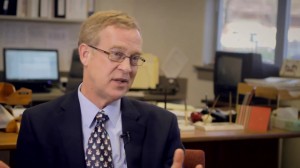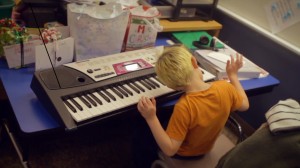For 125 years, the Washington State School for the Blind (WSSB) has pursued its primary purpose of educating and training the visually impaired. Today, learning to read Braille still goes hand-in-hand with regular school work, but training also includes developing daily living skills, computer skills, and job skills.
In 1886, three years before Washington became a state, the blind school was founded as a territorial school. One hundred years later, in 1986, Dr. Dean O. Stenehjem arrived as the director of education and principal to run a program that now serves more than 2,000 visually impaired throughout the State of Washington. Stenehjem is now the school’s superintendent. The students who come under his purview range in age from birth to 21.
Stenehjem sets high standards for himself, his staff, and his students as he pursues a very comprehensive strategic plan which is reviewed and updated every two years. His target is to make students as independent as possible with marketable talents that lead to full-time employment.Students who attend WSSB live on campus and are bused in each week from throughout the state. They travel back home every weekend – a less expensive option then Saturday and Sunday housing. The data shows that the weekdays they spend on campus garner them huge amounts of skill in a relatively short time. Before enrolling in the school, prospective students go through a pre-test to assess education level, core blindness skills, and life abilities. At the end of their first year they take a post-test.
“It’s not uncommon for us to see a year to a year-and-half to five years growth in a period of eight months,” says Stenehjem.
Occasionally, that trajectory toward success faces setbacks. Shortly before the transition back to the home school, WSSB staff may see intentional failure. The taste of success may not be something students want to lose.
“Probably for the first time in their life they’ve had huge successes and have earned a level of independence they want to retain,” says Stenehjem.
Returning home, however, does not end the relationship with the blind school. For eight years after graduation the school tracks each student. Stenehjem reports his students rate well above average in success when compared to the general population of visually impaired. Graduates from WSSB have an 80 to 82 percent success rate in the job market, while nationally the visually impaired experience just the reverse, a dismal unemployment rate of 60 to 70 percent.
The hurdle Stenehjem’s students face is the absence of incidental learning experiences. Stenehjem says most incidental learning occurs visually. The job of the school is to translate those missed lessons and cues into learning opportunities that begin the moment the student starts their day.
“When kids get up in the morning, someone starts working with them on grooming skills, on eating skills. We don’t serve breakfast. We help the kids make their own breakfast. Kids aren’t allowed to take their laundry home. We teach them how to do their laundry, how to mark their clothes, what looks good together, what doesn’t look good together, because they’re going to have to live in a sighted society,” he says.

The concert benefits Pacific Foundation for Blind Children and School of Piano Technology for the Blind.
“It’s not so much about teaching a kid to be a downhill skier…if you’re a totally blind kid…and you can downhill ski, you can probably do anything. That’s a huge confidence builder.”
The intense academics and extra activities are possible because the school is managed “much like a private business,” says Stenehjem, which may attest to his longevity as the longest serving superintendent in Southwest Washington.
The business of providing all these services is done through “hundreds and hundreds of partnerships.” Parents, community volunteers, school districts, event sponsors, businesses such as Microsoft, and even an Oregon university create the network of WSSB partnerships.
Housed on-site is the Lions Low Vision Clinic managed by Pacific University’s School of Optometry. The clinic trains about 36 optometry students a year who conduct comprehensive eye evaluations to anyone in the community.
WSSB also has programs that reach across the U.S. The school provides Braille for textbooks, high-stakes testing, and “Brailling” for the New York City Transit system. There’s even a program with a women’s prison.
When the school’s facilities are not in use by students, about 50,000 people access the grounds and housing for seminars, conferences and workshops, and the grounds are spectacular when it comes to environmentally friendly practices.
Starting in the early 1990s WSSB was ahead of the eco-curve. The school’s administration started pushing for energy conservation and reducing the school’s carbon footprint. That mindset transformed a chlorine-rich swimming pool into a mild salt-water pool. The savings cut the pool’s operations and maintenance almost in half – dollars that now go into programs.
The installation of two solar systems, a campus building that has an earthen roof, and a bioswale that filtrates all the water before it goes back into the ground are some of the other eco-friendly amenities. WSSB staff take these on-campus concepts and teach them in environmental science classes.
Stenhjem provides incredible experiences for his students to instill the belief that they can do just about anything, and 125 years after the school opened that still rings true. The visually impaired can be independent, they can ski, take photos, play music, paint murals – and a blind friend of Stenhjem’s even demonstrated driving a car (in a safe environment).When Stenehjem hears people ask, “What are the jobs that a blind person can’t do?” he wants everyone to change the basic question to, “What can they do?” The school challenges students to face their fears, and Stenehjem asks the community to do the same.
“If we have those inner feelings sometimes it makes it difficult for some of us to hire blind people,” he says.
CREDITS
Video captured and edited by Jordan Thompson
Next week COUV.COM releases an eight minute video on the Washington State School for the Blind Natural History Museum – one of the school’s efforts to educate the blind and help the sighted population overcome fears that blindness may instill.
Washington State School for the Blind
2214 E 13th St
Vancouver WA 98661
360-696-6321











